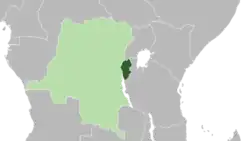Ruanda-Urundi
Ruanda-Urundi was a part of German East Africa. Belgian troops invaded during World War I. The military occupation lasted from 1916 to 1924 when the territory came under Belgian rule. In 1964 it became the independent states of Rwanda and Burundi.
Territory of Ruanda-Urundi | |||||||||||
|---|---|---|---|---|---|---|---|---|---|---|---|
| 1916-1962 | |||||||||||
.svg.png.webp) Flag
 Coat of arms
| |||||||||||
 Ruanda-Urundi (dark green) depicted within the Belgian colonial empire (light green), c. 1935 | |||||||||||
| Status | Mandate of Belgium | ||||||||||
| Capital | Usumbura | ||||||||||
| Common languages | French (official) Also: Kinyarwanda, Kirundi and Swahili | ||||||||||
| Religion | Catholicism Also: Protestantism, Islam and others | ||||||||||
| History | |||||||||||
• Belgian invasion | April 1916 | ||||||||||
• Mandate created | 20 July 1922 | ||||||||||
• Administrative merger with Belgian Congo | 1 March 1926 | ||||||||||
• Mandate becomes Trust Territory | 13 December 1946 | ||||||||||
• Rwanda gains autonomy | 18 October 1960 | ||||||||||
• Burundi gains autonomy | 21 December 1961 | ||||||||||
• Independence | 1 July 1962 | ||||||||||
| Currency | Belgian Congo franc (1916–60) Ruanda-Urundi franc (1960–62) | ||||||||||
| |||||||||||
| Today part of | |||||||||||
Royal administrators
Royal Commissioners
- Justin Malfeyt (November 1916-May 1919)
- Alfred Frédéric Gérard Marzorati (May 1919-August 1926)
Governors (Deputy Governors-General of the Belgian Congo)
- Alfred Frédéric Gérard Marzorati (August 1926-February 1929)
- Louis Joseph Postiaux (February 1929-July 1930)
- Charles Henri Joseph Voisin (July 1930-August 1932)
- Eugène Jacques Pierre Louis Jungers (August 1932-July 1946)
- Maurice Simon (July 1946-August 1949)
- Léon Antoine Marie Pétillon (August 1949-January 1952)
- Alfred Claeys Boùùaert (January 1952-March 1955)
- Jean-Paul Harroy (March 1955-January 1962)
This article is issued from Wikipedia. The text is licensed under Creative Commons - Attribution - Sharealike. Additional terms may apply for the media files.